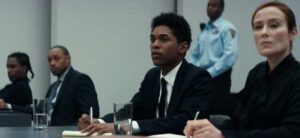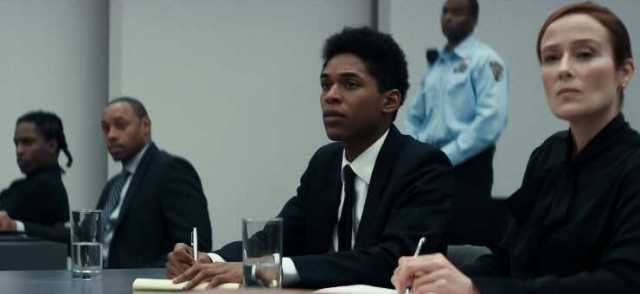Movie Info
Movie Info
- Director
- Anthony Mandler
- Run Time
- 1 hour and 14 minutes
VP Content Ratings
- Violence
- 2/10
- Language
- 3/10
- Sex & Nudity
- 1/10
- Star Rating
Relevant Quotes
Justice, and only justice, you shall pursue, so that you may live and occupy the land that the Lord your God is giving you.
A worthless witness mocks at justice, and the mouth of the wicked devours iniquity.
Rated TV-MA

Hitherto director of a huge number of music videos, Anthony Mandler’s feature film debut is as timely as the news headlines, even though it was filmed four years ago. Centered on the life of Steve Harmon (Kelvin Harrison, Jr.) a 17-year-old Black film student, the script was adapted from the novel by Walter Dean Myrs. Though well received three years ago at Sun Dance, the film has languished until now, with Netflix picking it up.
Though living in Harlem, the Harmon family is comparatively well off, Mr. Harmon being a graphic designer. The parents (Jennifer Hudson and Jeffrey Wright) have enrolled Steve in a posh downtown school, Stuyvesant High School. He is well thought of at school, especially Mr. Sawicki (Tim Blake Nelson), who teaches a film class and advises the school film club. Steve is very close to his little brother Jeremy, not at all minding the times when he must watch him when the parents are away. Bicycling around Harlem with his camera ever at ready, Steve’s prospects of enrolling in film school and becoming a filmmaker seem bright
Then comes the unfortunate day when the neighborhood bodega is robbed and the owner shot and killed by two neighborhood toughs James King (Rakim Mayers, also known as rap star ASAP Rocky) and “Bobo” Evans (John David Washington). Steve has just emerged from the store shortly before the robbery, and according to a white woman walking by the store, the youth had given a signal. Thus on a dark night shortly after the killing the police show up at the Harmons’ home and take the boy away in handcuffs, much to the consternation of the family.
The white defense lawyer Katherine O’Brien (Jennifer Ehle) matter of factly tells Steve that he is assumed guilty by the police and prosecution simply because he is a Black male. His chances of being found innocent are slim unless the jury can be persuaded to accept his story. She warns, “Half that jury … decided that you’re guilty the moment they laid eyes on you. You’re young, you’re Black and you’re on trial. What else do they need to know?” Steve will have to take the stand in his own defense.
Steve has to spend considerable time in jail before and during the trial. Rap singer Nas is fellow prisoner Raymond ‘Sunset’ Green whose sage advice probably saves Steve’s neck when the boy keeps staring at some tough inmates, setting them up for camera shots, Green warns him that those guys do not like being stared at. Steve’s anguish at being separated from his loving family is well set forth in their short visits and a phone call he manages to make, but which is cut short by a hostile inmate.
The courtroom scenes are intense, with Steve and his lawyer on one side and the two robbers and their lawyer on the opposite side to the right of the prosecution. The prosecutor Anthony Petrocelli (Paul Ben-Victor) stacks the deck by describing the murder and as he points at King and then at Steve declaring that each is a “monster,” hence the title—the latter takes on irony as we see scenes in Steve’s loving home and in his film class room. Interspersed are other scenes of Steve riding his bicycle around the neighborhood shooting others with his camera. It is revealing that on numerous occasions he has filmed James King, who takes a liking to the naïve boy. King seems to think it is his mission to conduct Steve around to show his darker side of the neighborhood. King obviously sees more in their relationship than Steve does, telling him that he (Steve) has his back, just as he has his. During one of their encounters King introduces Steve to Bobo.
A classroom scene in which teacher Sawicki is leading a discussion of Akira Kurosawa’s classic Rashomon is important in understanding the point of Mandler’s film. The Japanese film tells the story of a rape from a number of perspectives so that we learn that there is more than one way to view an event. Sawicki applies this to their role of filmmakers, “You embrace your point of view and you tell your truth…as you know it.”
Thus Steve is depicted from a number of viewpoints. To his family he is the talented, loving son and brother. To his teacher a hardworking student with a great future as a filmmaker. To King a naïve kid needing tutoring and who can be used. To his dedicated lawyer O’Brien a decent youth whose innocence she believes in so strongly that she rejects the prosecutor’s offer of a plea deal. To that prosecutor Steve is just another Black thug, “a monster”—this despite the boy’s clean record and excellent academic record. (We wonder if the prosecutor even bothered to look into the boy’s background, instead accepting the claim of a guilty drug dealer that the boy “volunteered” to join in their robbery plan.) The question to which the trial’s events leads up to is “How will the jury see the Black youth?”
Several times the fuzzy black and white surveillance camera recording of the robbery is shown. At the climax we see what did transpire, and it reminds us that “truth” is more complex than it is usually thought to be. It might trigger a number of questions: how complicit is Steve in the event? Was he a pawn, or might he have done something different that could have changed the outcome? Or was he too young to even think of any risk-laden action, even though a man’s life hung in the balance?
The film has been narrated by Steve, who at the beginning compares his story to a movie. “This is that movie,” he says, “Written, directed and starring Steve Harmon.” It is left up to us to decide whether Steve is the hero or the hapless victim. The film could be seen as a cautionary tale about being careful with whom you associate. I am sure it is a lesson Steve will take to heart. And of course, it is about justice as one perceives it, something the Hebrew-Christian Scriptures are very concerned with. Our secular law is symbolized by a blind Lady Justice holding the sword of power in her left hand and a balance scale in the other. Lawyer Katherine O’Brien supports the majority Black view that says that there is a hole in the blindfold, and that when she sees that the skin color of the supplicant is not white, she raises her sword to balance the scale against that person. As the courtroom proceedings move to its climax we anxiously wait to learn how the jury sees Steve. We know the outcome in the last century trials of To Kill a Mockingbird and If Beale Street Could Talk, but what about this jury of the 21st century?
This review will be in the July issue of VP along with a set of questions for reflection and/or discussion. If you have found reviews on this site helpful, please consider purchasing a subscription or individual issue in The Store.
Netflix

